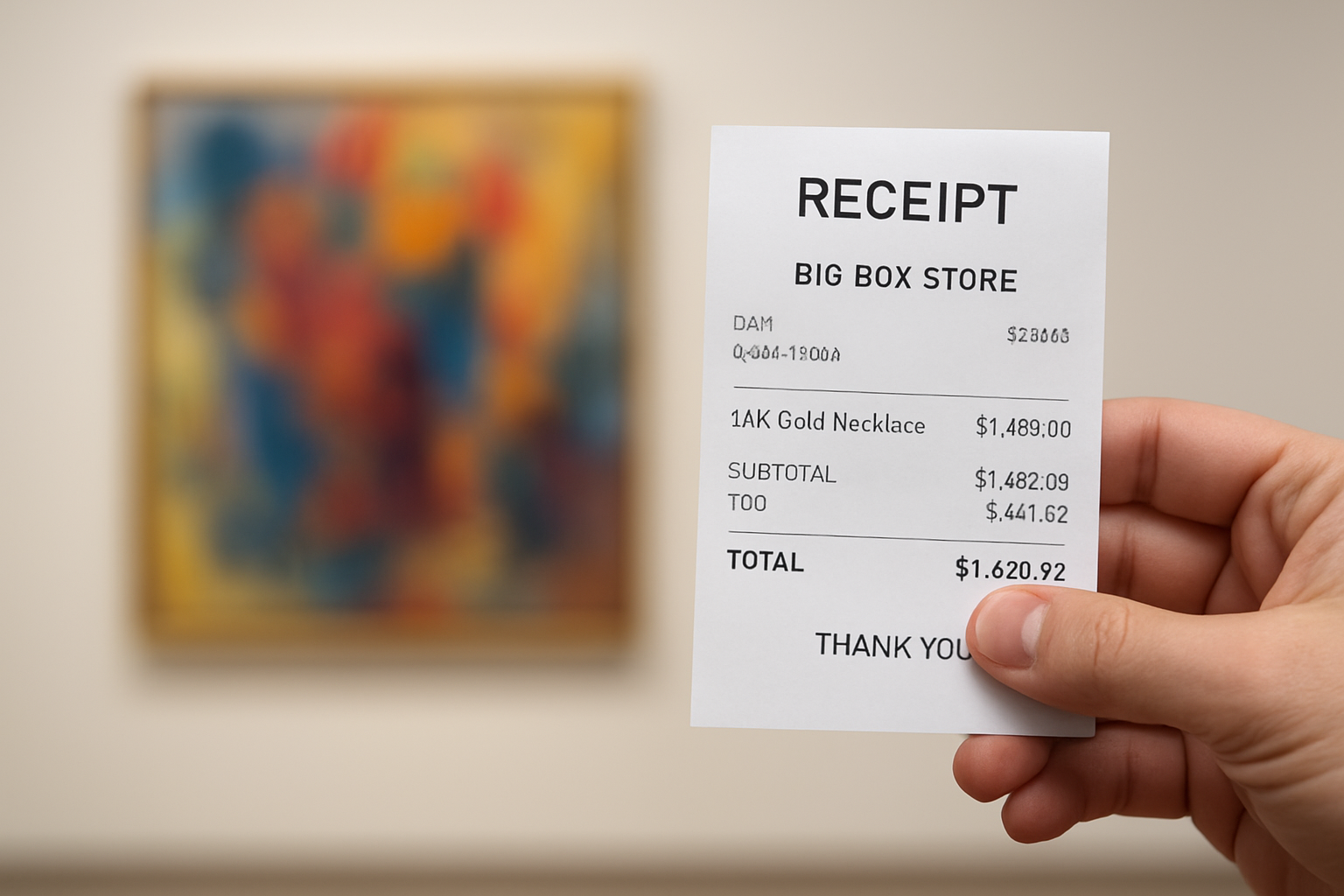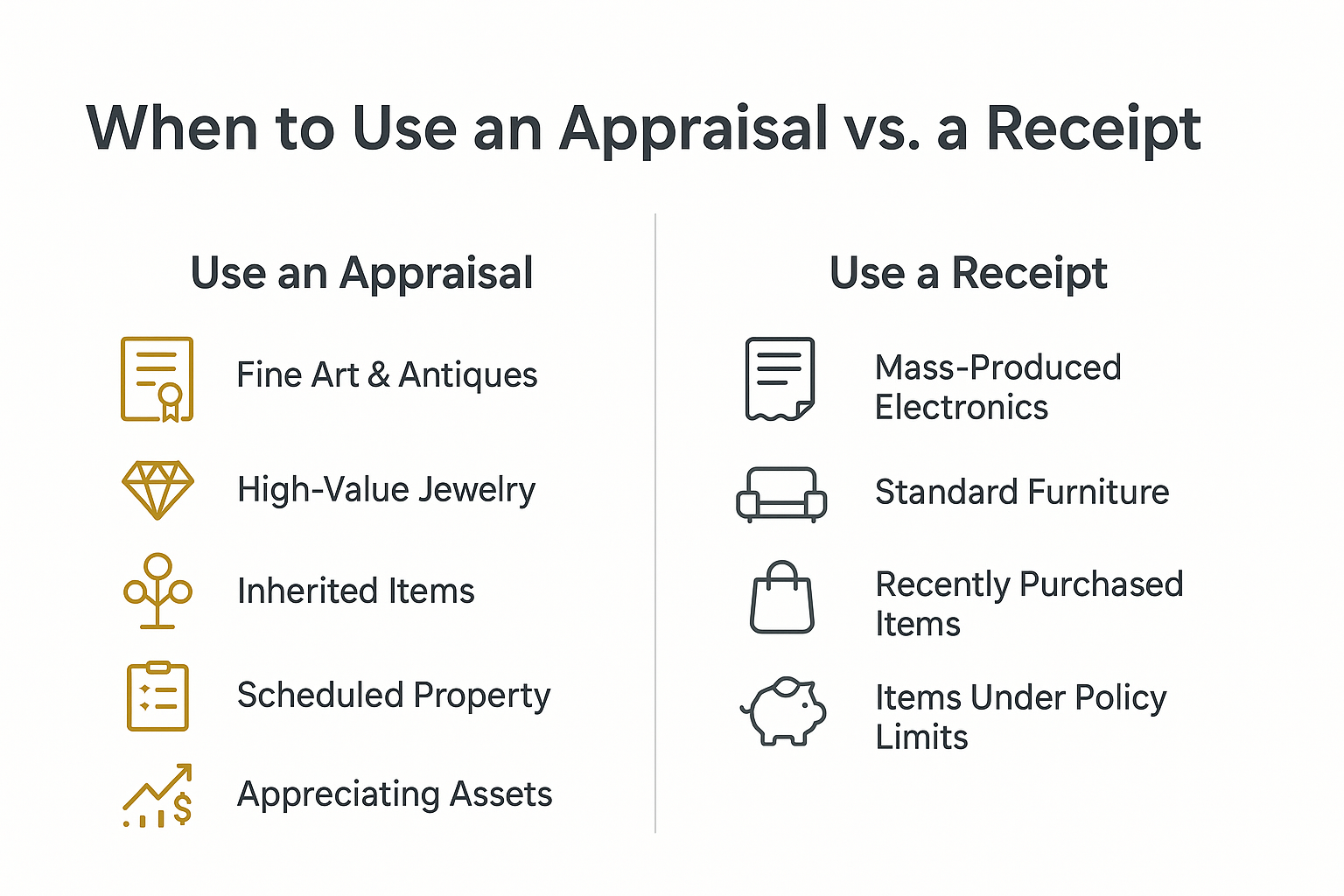






When you file an insurance claim for a lost, stolen, or damaged valuable, your provider will ask for one thing above all else: proof of value. The two most common forms of documentation are a purchase receipt and a professional appraisal, but they are not interchangeable.
Providing the right documentation is crucial for a smooth claims process and a fair settlement. The wrong type can lead to delays, underpayment, or even a denied claim.
Key Takeaway: Having the right documentation before a loss occurs is the single best way to protect yourself from underpayment or a denied claim.
This guide will walk you through the difference between appraisals and receipts, what insurance assessors look for, and how to ensure you have the right proof of value to protect your assets.
An appraisal is a professional assessment of an item’s fair market value, prepared by a qualified appraiser who follows recognized standards. For insurance purposes, most appraisals must comply with the Uniform Standards of Professional Appraisal Practice (USPAP)—the accepted ethical and performance standards for the appraisal profession in the United States.
A professional appraisal establishes an item’s current market value, not its historical purchase price. This distinction is critical.
Crucial Distinction: An appraisal establishes an item’s current market value, while a receipt only shows its historical purchase price. This difference is vital for items that appreciate over time.
A USPAP-compliant report is a comprehensive document. It includes detailed descriptions of the item—covering materials, dimensions, and unique characteristics—along with clear photographs. It also explains the appraiser’s methodology, referencing current market analysis and comparable sales to justify the valuation. Crucially, it includes the appraiser’s credentials and a certification statement, affirming the report meets professional standards.
Insurance carriers typically require professional appraisals for high-value items, especially those that exceed your policy’s sublimits (often $5,000 to $10,000). This is also true for property with fluctuating or appreciating values like fine art, antiques, and collectibles. Unique or one-of-a-kind items without a standard retail market, as well as high-value jewelry, also fall into this category. Essentially, if you plan to schedule an item separately on your policy for a specific coverage amount, you will almost certainly need an appraisal.

A receipt serves as proof of purchase. It documents the transaction amount, purchase date, seller, and item description at the time of sale.
For a receipt to be valid for an insurance claim, it must clearly identify the seller, provide a description of the item or its model number, and show the date and amount of the purchase. This can be supplemented with proof of payment, such as a credit card statement or bank record.
Receipts are generally sufficient documentation for recently purchased items, particularly mass-produced consumer goods like electronics or standard furniture with established retail prices. They are also acceptable for items valued below your policy’s appraisal threshold and for claims settled at actual cash value (ACV), where depreciation is a factor.
Warning: Relying on a receipt for appreciated assets like art, antiques, or collectibles will likely result in an undervalued claim, as it doesn’t account for increases in market value.
The biggest limitation of a receipt is that it only proves historical purchase price, not current value. This becomes a problem in several key scenarios. For items that appreciate over time—like art, antiques, or collectibles—the receipt understates current value. It also fails to establish an item’s condition at the time of loss. Finally, many valuable items, such as inherited property or gifts, lack receipts entirely, making it necessary to establish value through other means.
When you file a claim, an insurance assessor (or claims adjuster) evaluates your documentation to determine your settlement. Understanding what they look for helps you provide the right information from the start.
First, an assessor needs to verify you owned the property. You can establish ownership with purchase receipts, professional appraisals, or even photos of the item in your home. For inherited items, estate documents or gift letters are crucial. The higher the value of the claim, the more scrutiny you can expect, so providing multiple forms of proof will strengthen your position.
The assessor then determines the settlement value based on your policy terms—replacement cost versus actual cash value. For appraisal-based claims, they will review the report’s methodology, the appraiser’s credentials, and the date of the valuation. Recent appraisals from the last three to five years carry the most weight.
Pro Tip: A USPAP-compliant appraisal from a credentialed professional is your strongest evidence. It is difficult for an insurance carrier to dispute, often leading to a faster and fairer settlement.
Assessors also cross-reference your claimed value against their own resources, such as valuation databases, recent auction results, and industry pricing guides. They are trained to spot inflated claims, which can lead to denial or even a fraud investigation. In contrast, a professional appraisal with well-documented market analysis is difficult to dispute and often leads to a faster, smoother resolution.

You should prioritize getting a professional appraisal in several key situations. First, it’s essential for items that exceed your policy’s sublimits for categories like jewelry or art, as this is the only way to insure them for their full value. Second, an appraisal is critical for property that has appreciated significantly since you acquired it—such as antique furniture, fine art, or vintage watches—where a receipt would drastically understate its worth. It’s also necessary when you lack purchase receipts for inherited items or gifts. Finally, unique or rare items require an appraisal to establish value, and it is a standard requirement if you want to schedule property for higher coverage limits and broader protection.
Conversely, receipts are usually adequate for more common items like recently purchased electronics, mass-produced furniture, and standard jewelry that hasn’t appreciated. If the item’s value falls within your policy’s standard limits and you’re claiming its depreciated actual cash value, a receipt is often all you need.
How recent does my appraisal need to be for insurance purposes?
Most insurers prefer appraisals from the last 3-5 years. For rapidly appreciating markets like fine art or certain collectibles, more frequent updates ensure your coverage keeps pace with value increases. Check with your insurance agent for your carrier’s specific requirements.
Can I use an online valuation tool instead of a professional appraisal?
Online tools can provide estimates, but insurance companies do not accept them as sufficient documentation for high-value claims. They lack the detailed analysis, professional credentials, and USPAP compliance that insurers require for a defensible valuation.
What happens if my insurance company disagrees with my appraisal?
If your carrier disputes a valuation, they may request a second opinion or additional documentation. However, a well-researched, USPAP-compliant appraisal from a qualified professional is difficult to contest and is your strongest tool in supporting your claim.
Do I need separate appraisals for each item I want to schedule?
Not necessarily. An appraiser can prepare a single comprehensive report covering multiple items, such as an entire art or jewelry collection. Each item will be individually described, photographed, and valued within the report.
The time to protect your property is now, before you need to file a claim. Start by reviewing your insurance policy to understand your coverage limits and documentation requirements. Then, inventory your valuables, identify which ones need special attention, and obtain professional appraisals for any high-value, rare, or appreciated items. Keep your receipts organized for everything else, and remember to update your appraisals every few years as values change.
The difference between a receipt and an appraisal isn’t just a technicality—it determines whether you receive adequate compensation when a loss occurs. For your most valuable property, a professional appraisal provides the documentation insurance companies require and the protection you deserve.
Ready to protect your property with professional documentation? AppraiseItNow provides USPAP-compliant appraisals for insurance purposes across all property categories, including fine art, antiques, jewelry, and collectibles. Our credentialed appraisers deliver detailed reports that insurance carriers accept, ensuring you have the proof you need before you file a claim.
Contact us today for a quote and take the first step toward comprehensive protection.




